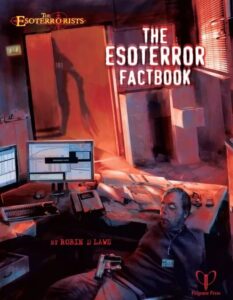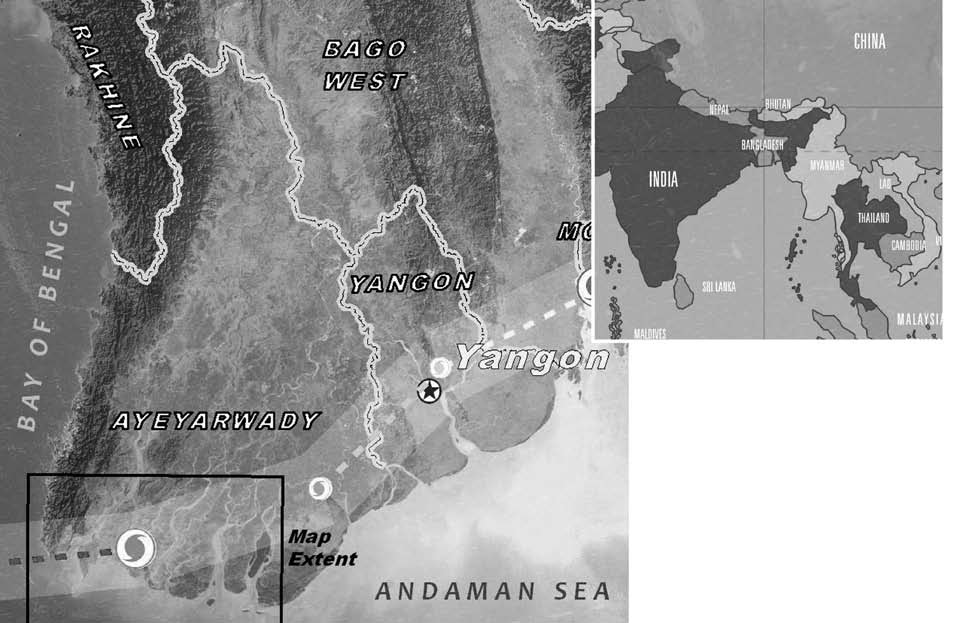Please note that this review was originally posted over on RPGGeek and is mirrored here for completist reasons only!
 You know that feeling, the one that goes… “hang on now, they’ve definitely set this all up for a sequel, right?”. Well, that’s what I always felt when reading the original The Esoterrorists roleplaying game (the core rulebook now known as 1st Edition). Written by Robin D. Laws and published by Pelgrane Press in 2006, here you had gem of a great set of mechanics (the vast majority of what we know today as the GUMSHOE system), but no real substance behind it. I mean in The Esoterrorists 1st Edition you got the bare bones of anything you might realistically call a ‘game setting’, and worse, it really felt like a ‘quickie’ knock off of other more intriguing modern horror settings such as Delta Green, Hunter or even Conspiracy X. Sure, one could see that somewhere in the text there was a really neat unique game world just waiting to let loose … but where, oh where, was it!
You know that feeling, the one that goes… “hang on now, they’ve definitely set this all up for a sequel, right?”. Well, that’s what I always felt when reading the original The Esoterrorists roleplaying game (the core rulebook now known as 1st Edition). Written by Robin D. Laws and published by Pelgrane Press in 2006, here you had gem of a great set of mechanics (the vast majority of what we know today as the GUMSHOE system), but no real substance behind it. I mean in The Esoterrorists 1st Edition you got the bare bones of anything you might realistically call a ‘game setting’, and worse, it really felt like a ‘quickie’ knock off of other more intriguing modern horror settings such as Delta Green, Hunter or even Conspiracy X. Sure, one could see that somewhere in the text there was a really neat unique game world just waiting to let loose … but where, oh where, was it!
Well, you’ll be pleased to know, 2009’s The Esoterror Factbook (also by Robin D Laws) is that missing ingredient; the background, context and detail that finally brings The Esoterrorists into its own… just a shame so few people know it even exists….
Please note, this review is written with the assumption that you, the reader, has some knowledge of The Esoterrorists roleplaying game. For those of you who might not be as familiar with the setting, my ‘one sentence descriptor’ would be – A modern day, conspiracy horror game of operatives (working for the secretive Ordo Veritatis) protecting our reality from the cold, dark nihilism of the ‘Outer Dark’, a realm outside our reality, and the insane entities that inhabit it.
The Physical Book
Coming in at a chunky 150 pages (almost double the size – at just 88 pages – of the original 1st Edition core rule book), The Esoterror Factbook is a collection of material expanding The Esoterrorists game setting and mechanics. It is aimed at both players and Game Masters alike, but is probably of more use to the later. Content wise it is presented as a ‘quasi-realistic’ handbook, both in design and the language used within the text (maybe making it a document you could almost use as an in-game handout?). It is presented in a functional two-column layout – the same as used in the 1st Edition rulebook – and is littered with lots of art (all of which are presented as if they were photographs having been taped into the handbook). This interior art is quite good, the vast majority being quarter-page black & white images, but very little of it stands out as exceptional (and it all looks a little too dark in the pdf version I’m using for this review). The text itself, however, is well laid out and uses the very readable Book Antiqua font. The same, unfortunately, can’t be said for the Typewriter style font that is utilised for the myriads of headings, which is a little jarring in this context. But hey, that is me being a bit nit-picky, if I’m being honest.
An Aside – The Cover
So, before we look inside the Factbook itself, we really, really need to linger for moment on its intriguing cover. This is a fantastic piece of art, depicting the aftermath of an attack by an ‘Outer Dark Entity’ (the monsters of the setting). It is exceedingly creepy, with a real nice use of reds and pinks to perfectly reflect its horrific tone, and probably pushes the boundaries regarding ‘acceptable imagery’ for modern roleplaying games (which is to say that it is perfect for this particular game!). Drawn by Jerome Huguenin, it probably does more to reflect the ideal feeling/atmosphere of the Esoterrorists than just about every other piece of art depicted across the game’s other releases (although, I have to say, the original 1st Edition cover wasn’t too bad either!). It’s one of those covers that really draws you in and gets a big ‘thumbs up’ from me!
The Content
Okay, so I’ve chatted about the need for this book, as well as its layout and art design, but what about the actual content of the supplement? Well let me just say ‘It’s good… real good!’. Divided into six main sections, the Factbook covers a plethora of material from the likes of ‘what are the standard operating procedures undertaken by operatives in the field’, through the use of the Ordo Vertiatis’ ‘Special Suppression Forces’ commando units, and into a good sampling of example Esoterrorist cells and Outer Dark related locations. Since the book does such a worthy job at presenting all this diverse information, I thought it was best if I break the next part of my review down in this same structure.
Operations Manual
The first section of the book covers how typical operations – if there is such a thing in these sorts of games – are undertaken by operatives of the Ordo Veritatis. This is a guide to everything from exactly how a case (or mission) is assessed and assigned, through to the standard operating techniques operatives should follow in their investigations, and what to do when managing contact with a Esoterrorist threat. Of most importance (given the themes of the game) is the detail provided around conducting the ‘Veil Out’. This is the act of trying to hide the actions (and outcomes) of any Esoterrorists actions and ensure as little public awareness as possible. As anyone familiar with the setting will know, the greater the belief in the supernatural (i.e. magic, madness, monsters) the weaker the barrier – or the Membrane – becomes between our reality and the Outer Dark. If the operatives don’t clean up properly after a mission, then no matter how successful they are in defeating the threat, they will still erode the Membrane, the only thing protecting humanity from annihilation!
After those cheery thoughts, another good addition to this section is the Adversary Map. This map (which I’d hazard a guess is a precursor to the Conspiracy Pyramid that would later appear in another great GUMSHOE game ‘Night’s Black Agents’), details the hierarchy and connections within (and without) an Esoterrorist cell. The success in ‘mapping out’ these cells is an obvious goal for the Ordos, and the Adversary map allows for an excellent in-game tool that can drive the investigation (in addition to being a neat little physical prop/handout that can sit in the middle of the game table). In practice it is pretty easy to whip up one of these maps and given that these connections can grow (or shrink) depending on the operatives actions or success, it becomes a great tool for managing the overall narrative of a campaign.
All in all, the Operation Manual section is very well written, and it fills many of the gaps seen in the 1st Edition rulebook. Over the span of 30-odd pages we get a lot of detail on why Ordo Veritatis exists and how it operates, and this detail is probably worth the purchase price of the supplement alone.
Special Suppression Forces
A relatively short section, as least compared to the others in the book, this chapter details the use of Special Suppression Forces (the Ordos’ equivalent of Delta Force or the Secret Air Service). While the information on this unit is interesting, it’s the so-called ‘Extra-Crunchy Combat’ rules that act as the real point of difference. Here we get everything from rules on everything from how to better reflect the effectiveness of automatic weapons, making ‘called shots’, and handling extra attacks, etc. Most of these rules are simply new ways in which to use existing ability pools to enhance, or alter, the outcome of an action/die roll, but where I start to get a little leery is around the mechanics to ‘refresh ability pools’. As you might recall these pools are the core of the GUMSHOE system, reflecting the capabilities of the character why also acting as a pseudo-currency in the meta game.
To explain that later point a bit further, pools in GUMSHOE are used in one of two ways, either to enhance the information a character gets from their Investigative Abilities or spent to add to any rolls made with their General Abilities. While the Extra Crunchy Combat rules impact only the use of General Abilities, the move away from having a finite set of resources, to now allowing these pools to ‘refresh’ in an ad-hoc manner undermines – at least in my opinion – part of the core concept of GUMSHOE. To be honest, I have a real mixed feeling about these additions, as while on the one hand they really do fill somewhat of the mechanical gap needed to represent ‘well trained, highly skilled operatives in the field’, they do also undermine the game’s shear simplicity (personally, I feel this is something people already struggle with in GUMSHOE games; the idea of a light and simple ruleset verses the abstraction of Ability pools to make it so).
So, overall, while I think this mechanics and rules noted in this section are probably important for an action/combat heavy style of play, they come with a bit of an additional overhead, that depending on your own opinion, may or may not be worth the effort.
The Enemy
 In this section we really get to the core of what this supplement adds to The Esoterrorists. As I mentioned in the intro to this review, the idea of what ‘Esoterrorism’ is (and by extension who the Esoterrorists themselves are) was never clearly described in the 1st Edition core rulebook, and here, finally, we finally get that long-needed detail.
In this section we really get to the core of what this supplement adds to The Esoterrorists. As I mentioned in the intro to this review, the idea of what ‘Esoterrorism’ is (and by extension who the Esoterrorists themselves are) was never clearly described in the 1st Edition core rulebook, and here, finally, we finally get that long-needed detail.
And boy doesn’t it just deliver! From discussions on the Esoterrorist’s funding models (always follow the money, as they say!), through an examination of the diverse psychological make-ups and motivations of these ‘cults’, and even a deep dive into the way(s) such cells operate, we get an excellent, detailed overview of what makes up various aspects of the Esoterrorism movement. Better yet all this information is presented in a way that acts as both a ‘grab bag’ of ideas for Game Masters (i.e. you can use just one or two of these ‘options’ without having to take it all) as well as providing plenty of inspiration on how one might expand on these concepts to create your own distinct enemy. The precis on ‘Esoterror Leadership: An Oxymoron?’ is an especially interesting, as it both supports and yet rejects the idea that all Esoterrorist cells are somehow connected in a unifying grand conspiracy.
Now this is what I’m talking about when I’ve said the core rule book came up short. The information outlined here makes you think about how you might structure your stories, and I think it is these sorts of snippets of discussion and deep dives into key setting aspects is what really brings a game, but especially The Esoterrorists, to life. Better still by doing so in a way that allows each Game Master (and their group) to define just how their own Esoterrorists will ‘work’ at their own table adds a real flexibility and reusability of the content.
Beyond this great stuff, the section also provides a sampling of unique Esoterrorist Cells (with 10 examples given) and a good selection of standalone suspected Esoterrorist operatives (13 in total). Each of which has its own distinct motivations and conspiratorial goals, and while I’ll avoid going into too much detail on all of them (go buy this supplement, you won’t regret it), I do feel I should highlight a couple that really appealed to me.
Set in India (I have to say, it is refreshing to see a conspiracy based outside of the Western world), K-School is strange cult that leaves its actual motivations and even its modius operandi very open to interpretation. I believe that this is a group that could easily be picked up and placed in almost any location around the world and has plenty of potential to be involved in a series of adventures (where the operatives need to hunt down all the threads of this cell as they slowly break down the Membrane).
‘Uncle Joker’ (a.k.a Djoko Borcsok) is the standalone Esoterrorist example that it thought I should highlight. A purveyor of pornography and all the world’s social ills, everything this man represents is horrendous and repugnant, which in my way of thinking give you a real ‘bad’ guy for the Ordo to fight against. What exactly are Borcsok’s goals and what is the power he has seemingly gathered is the real mystery, however, and one that deserves being solved by the characters (if only to ensure this monster is put down once and for all!).
Unaffiliated Operatives
The world of The Esoterrorists isn’t one where everything is simply black or white. There are many individuals that ride the grey line between simply knowing the truth about our small pocket of reality (floating as it does amid that great black ocean of the Outer Dark) and being a card-carrying member of the Esoterrorists. This section explores some of those who (successfully?) negotiate this very (very) thin line – the so-called Unaffiliated Operatives (UOs). Here we are presented with a selection of these characters (8 in total), that range from The Anthropologist, an ex-Esoterrorist who may (or may not?) be looking to defect to the Ordos, through to Luciano Gaudio, a supposed broker of the occult, who seems just a little too happy to sell mystical artifacts and other esoterica to the highest bidder.
All eight of these descriptions are excellent, and each fills a niche that allows a Game Master to easily see them used in any style of Esoterrorists adventure. Some of these descriptions, such as the Serial Killer “Jimmy Wayne James” are a little rough read through (at least in terms of provocative content), but all are well written snap shots of those few that will live (and likely die) on what they know.
Dread Locations
The Membrane – that thinning barrier between our reality and the madness of the Outer Dark – is failing, and in this section we are treated to nearly a dozen locations where this decay has allow some of that inky madness in. From the Dark Church in Los Angeles through to the twisted forest of Perhakstka in Siberian, we learn what the happens when the Outer Dark seeps into our reality, and what the Ordos is doing to quarantine these locations and protect humanity from the truth.
As with the Enemy and Unaffiliated Operatives sections, each description is top notch, and all conjure up more than a few good scenario ideas that could be run with them. I particularly like the ‘Road to Nowhere’, a seemingly non- existent American Highway which when discovered drives its travellers insane, as well as The Caperton 1233, a specific set of house building designs that are known to be focus points for weakening the Membrane. Overall, these dozen examples give you nice, rounded selection of such mysterious locations with some nice ‘left field’ inclusions and a few more mundane offerings that have a good twist or two to freshen them up.
Of particular interest to Game Masters will be the information provided at the beginning of the chapter, where the nature of the Membrane (including its weakening and repair) are discussed. Here we get details on why the Membrane deteriorates and the revelation around just how close we are to the teetering edge our reality really is. Again, great stuff, although, I have to ask myself, why, oh why wasn’t this in the core rules!
GM Guidance
Where much of the text from earlier in this supplement was presented ‘in character’, this GM Guidance section is more like a traditional gaming book in its voice and structure. Then again, given that it details some important advice on how to develop and structure scenario ideas into workable adventures within the slightly rigid GUMSHOE framework, it does makes sense to alter the presentation style to something a little more formal.
Starting with just why The Esoterrorist adventures are constructed the way they are (to quote “this model keeps the players from feeling overwhelmed by an accumulation of ongoing plot detail or an ever-accumulating collection of potential threats to their well-being”), it encourages the Game Master to define a scenario’s premise that provides “an emotional or intellectual access point into your story”. This is good advice for creating any intriguing story (let alone one that forms the core of a roleplaying adventure) and supports this approach by going into more detail on how you might develop the key building blocks of the backstory, underlying mystery, and scenes, for reflect these points.
It also raises how a series of connected adventures (or even a campaign) might be created and how to manage the core conceits that we all have to accept to allow us to play a roleplaying game in this setting i.e. we live in a modern world that has set some expectations in regards to technology and social norms, and we also need to create a plot that can actually be ‘solved’ by the players. This is great advice and I’m thoroughly impressed by just how well the author was able to articulate these unique aspects of creating and playing games. On reflection, I really think that this section should probably be read by anyone looking to create a good mystery story or indeed any type of roleplaying adventure, as it feels like the advice given here will ring true in almost any medium.
Operation Whirlwind Reaper
This is a short, sharp 17-page scenario developed specifically for operatives of Ordos Veritatis’ Special Suppression Force (SSF; see my notes above for more details on this arm of the organisation), and as you’d likely expect, it is a very different type of scenario from what you’d normally find in The Esoterrorists; less investigation and a lot more combat.
In Operation Whirlwind Reaper, the characters are dropped into Burma on the trail of a known Esoterrorist organisation and are charged with the responsibility of eliminating the threat with all prejudice. Expect a few big guns and lots of big bangs, as the team finds themselves dealing with not only angry Burmese soldiers and rebellious militia, but also a well-armed and prepared Esoterrorist cell (who have a few nasty surprises awaiting our player characters).
I do like the idea of playing a more military focused version of the Esoterrorists (although I do question the GUMSHOE system’s ability to completely manage the expected experience), and suspect that an actual play of the scenario could be quite intense and confronting.
Overall Thoughts
Hmmm… that was a lot of words, wasn’t it… but what did I think of the book overall?
Well, first and foremost, the Esoterror Factbook is a really good supplement for The Esoterrorists, a grab bag of ideas that adds nicely to the foundation of the rulebooks (both editions) and the scenarios that are available for the game. I’d also happily say that it is also great addition to your gaming library if you have an interest in running any sort of modern, conspiracy horror game, as it demonstrates clearly how to build up the aspects of a mystery adventure to ensure a worthy session as the gaming table.
That said… and yeah you’ve probably gleaned this from my review this already… this stuff should have totally been in the core rulebook! Having this wonderful, gritty setting material separated out in another book is a real travesty, and in some ways, it feels a bit like Pelgrane intentionally hid all the really good Esoterrorists stuff behind a pay wall! I honestly think that if this material had been present in the 2nd Edition book* then the public opinion – and popularity – of The Esoterrorists would have increased three-fold.
So, that makes my final thoughts; great book, go get it… especially if you’ve ever had even the slightest interest in The Esoterrorists!
* As an aside, when a second edition of The Esoterrorists was released in 2013, I know the publishers intentionally decided not to incorporate the majority of the Esoterror Factbook into it. While I respect this from a business perspective (why force your loyal customers to purchase the same material twice), I personally find it difficult to separate the core Esoterrorists rules from the information provided in this book, which sort of means that old problem of ‘great game, but what do I do with it’ remained even after 2nd Edition’s release.




Leave a Reply